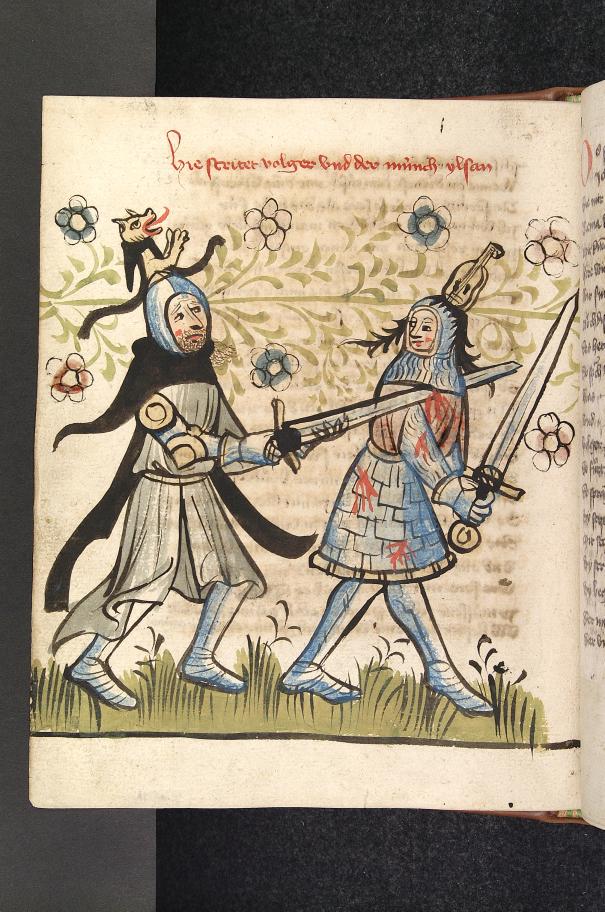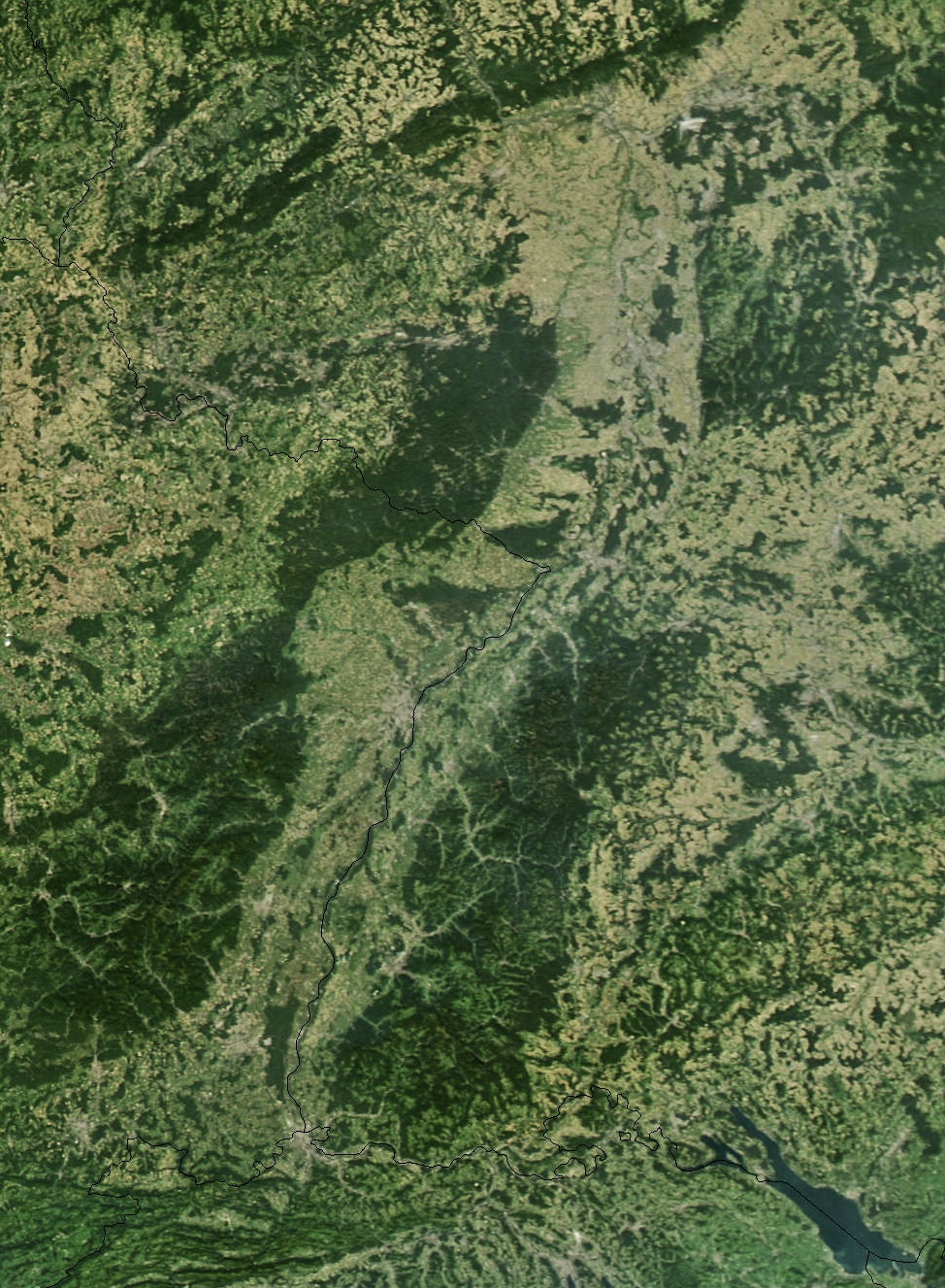|
Battle Of Göllheim
The Battle of Göllheim was fought on 2 July 1298 between the forces of duke Albert I of Habsburg (German: Albrecht) and king Adolf of Nassau over the prince electors' decision, without electoral act, to dethrone Adolf and proclaim Albert the new king. Adolf died in the battle. Background After the death of Rudolph I at Germersheim on 15 July 1291, his son Albert I was to be the most suitable successor to the throne of the Holy Roman Empire. However, Albert's undignified personality (ubiquitously called "Albert the One-Eyed", due to an open eye socket from a battle injury;) and his bad attitude dismayed the prince electors. Mostly, though, they feared too strong a kingship of the son of former king Rudolph I, who controlled one of the strongest domestic power bases in the empire. At the Imperial Diet near Frankfurt the following year, they resolved to elect Adolf of Nassau-Weilburg, a cousin of one of the electors, a man with very little domestic power. Although Albert publ ... [...More Info...] [...Related Items...] OR: [Wikipedia] [Google] [Baidu] |
Frankfurt
Frankfurt, officially Frankfurt am Main (; Hessian: , " Frank ford on the Main"), is the most populous city in the German state of Hesse. Its 791,000 inhabitants as of 2022 make it the fifth-most populous city in Germany. Located on its namesake Main River, it forms a continuous conurbation with the neighboring city of Offenbach am Main and its urban area has a population of over 2.3 million. The city is the heart of the larger Rhine-Main metropolitan region, which has a population of more than 5.6 million and is Germany's second-largest metropolitan region after the Rhine-Ruhr region. Frankfurt's central business district, the Bankenviertel, lies about northwest of the geographic center of the EU at Gadheim, Lower Franconia. Like France and Franconia, the city is named after the Franks. Frankfurt is the largest city in the Rhine Franconian dialect area. Frankfurt was a city state, the Free City of Frankfurt, for nearly five centuries, and was one of th ... [...More Info...] [...Related Items...] OR: [Wikipedia] [Google] [Baidu] |
Alsace
Alsace (, ; ; Low Alemannic German/ gsw-FR, Elsàss ; german: Elsass ; la, Alsatia) is a cultural region and a territorial collectivity in eastern France, on the west bank of the upper Rhine next to Germany and Switzerland. In 2020, it had a population of 1,898,533. Alsatian culture is characterized by a blend of Germanic and French influences. Until 1871, Alsace included the area now known as the Territoire de Belfort, which formed its southernmost part. From 1982 to 2016, Alsace was the smallest administrative ''région'' in metropolitan France, consisting of the Bas-Rhin and Haut-Rhin departments. Territorial reform passed by the French Parliament in 2014 resulted in the merger of the Alsace administrative region with Champagne-Ardenne and Lorraine to form Grand Est. On 1 January 2021, the departments of Bas-Rhin and Haut-Rhin merged into the new European Collectivity of Alsace but remained part of the region Grand Est. Alsatian is an Alemannic dialect closely related ... [...More Info...] [...Related Items...] OR: [Wikipedia] [Google] [Baidu] |
Lower Bavaria
Lower Bavaria (german: Niederbayern, Bavarian: ''Niedabayern'') is one of the seven administrative regions of Bavaria, Germany, located in the east of the state. Geography Lower Bavaria is subdivided into two regions () – Landshut and Donau-Wald. Recent election results mark it as the most conservative part of Germany, generally giving huge margins to the CSU. This part of Bavaria includes the Bavarian Forest, a well-known tourist destination in Germany, and the Lower Bavarian Upland. ''Landkreise''(districts) # Deggendorf # Dingolfing-Landau # Freyung-Grafenau # Kelheim # Landshut # Passau # Regen # Rottal-Inn # Straubing-Bogen ''Kreisfreie Städte''(district-free towns) # Landshut # Passau # Straubing Population Economy The Gross domestic product (GDP) of the region was 48.5 billion € in 2018, accounting for 1.4% of German economic output. GDP per capita adjusted for purchasing power was 36,100 € or 120% of the EU27 average in the same year. The GDP p ... [...More Info...] [...Related Items...] OR: [Wikipedia] [Google] [Baidu] |
Franconia
Franconia (german: Franken, ; Franconian dialect: ''Franggn'' ; bar, Frankn) is a region of Germany, characterised by its culture and Franconian languages, Franconian dialect (German: ''Fränkisch''). The three Regierungsbezirk, administrative regions of Lower Franconia, Lower, Middle Franconia, Middle and Upper Franconia (largest cities, respectively: Würzburg, Nuremberg and Bamberg) in the Bavaria, State of Bavaria are part of the cultural region of Franconia, as are the adjacent East Franconian, Franconian-speaking South Thuringia, south of the Rennsteig ridge (largest city: Suhl), Heilbronn-Franconia (largest city: Schwäbisch Hall) in the state of Baden-Württemberg, and small parts of the state of Hesse. Those parts of the Vogtland lying in the state of Saxony (largest city: Plauen) are sometimes regarded as Franconian as well, because the Vogtlandian dialects are mostly East Franconian. The inhabitants of Saxon Vogtland, however, mostly do not consider themselves as Fran ... [...More Info...] [...Related Items...] OR: [Wikipedia] [Google] [Baidu] |
Taunus
The Taunus is a mountain range in Hesse, Germany, located north of Frankfurt. The tallest peak in the range is '' Großer Feldberg'' at 878 m; other notable peaks are ''Kleiner Feldberg'' (825 m) and '' Altkönig'' (798 m). The Taunus range spans the districts of Hochtaunuskreis, Main-Taunus-Kreis, Rheingau-Taunus, Limburg-Weilburg, and Rhein-Lahn. The range is known for its geothermal springs and mineral waters that formerly attracted members of the European aristocracy to its spa towns. The car line Ford Taunus is named after it. Description It is a relatively low range, with smooth, rounded mountains covered with forest. The Taunus is bounded by the valleys of the Rhine, Main, and Lahn rivers and it is part of the Rhenish Slate Mountains. On the opposite side of the Rhine, The Taunus range is continued by the Hunsrück. For geographical, ecological and geological purposes the Taunus is divided in three parts: * Anterior Taunus ''(Vortaunus'' or ''Vordertaunus)'' in ... [...More Info...] [...Related Items...] OR: [Wikipedia] [Google] [Baidu] |
Alzey
Alzey () is a ''Verband''-free town – one belonging to no ''Verbandsgemeinde'' – in the Alzey-Worms district in Rhineland-Palatinate, Germany. It is the fifth-largest town in Rhenish Hesse, after Mainz, Worms, Ingelheim am Rhein and Bingen. Alzey is one of the ''Nibelungenstädte'' – towns associated with the '' Nibelungenlied'' – because it is represented in this work by the character Volker von Alzey. Hence, Alzey is also known as ''Volkerstadt''. Geography Location Alzey lies in Rhenish Hesse on the western edge of the northern part of the Upper Rhine Plain. It is surrounded by the northern part of the Alzey Hills, which meets the Rhenish Hesse Hills towards the south and the North Palatine Uplands towards the east. The town is found some 30 km southwest of Mainz and some 22 km ( as the crow flies, in each case) northwest of Worms. Through Alzey, in places underground, flows the river Selz, a left-bank tributary to the Rhine. Climate Yearly prec ... [...More Info...] [...Related Items...] OR: [Wikipedia] [Google] [Baidu] |
Prince-Bishopric Of Constance
The Prince-Bishopric of Constance, (german: Hochstift Konstanz, Fürstbistum Konstanz, Bistum Konstanz) was a small ecclesiastical principality of the Holy Roman Empire from the mid-12th century until its secularisation in 1802–1803. In his dual capacity as prince and as bishop, the prince-bishop also governed the Diocese of Konstanz, which existed from about 585 until its dissolution in 1821, and whose territory extended over an area much larger than the principality."Diocese of Konstanz " ''''. David M. Cheney. Retrieved February 29, 2016 [...More Info...] [...Related Items...] OR: [Wikipedia] [Google] [Baidu] |
Mainz
Mainz () is the capital and largest city of Rhineland-Palatinate, Germany. Mainz is on the left bank of the Rhine, opposite to the place that the Main joins the Rhine. Downstream of the confluence, the Rhine flows to the north-west, with Mainz on the left bank, and Wiesbaden, the capital of the neighbouring state Hesse, on the right bank. Mainz is an independent city with a population of 218,578 (as of 2019) and forms part of the Frankfurt Rhine-Main Metropolitan Region. Mainz was founded by the Romans in the 1st century BC as a military fortress on the northernmost frontier of the empire and provincial capital of Germania Superior. Mainz became an important city in the 8th century AD as part of the Holy Roman Empire, capital of the Electorate of Mainz and seat of the Archbishop-Elector of Mainz, the Primate of Germany. Mainz is famous as the birthplace of Johannes Gutenberg, the inventor of a movable-type printing press, who in the early 1450s manufactured his first ... [...More Info...] [...Related Items...] OR: [Wikipedia] [Google] [Baidu] |
Upper Rhine
The Upper Rhine (german: Oberrhein ; french: Rhin Supérieur) is the section of the Rhine between Basel in Switzerland and Bingen in Germany, surrounded by the Upper Rhine Plain. The river is marked by Rhine-kilometres 170 to 529 (the scale beginning in Konstanz and ending in Rotterdam). The ''Upper Rhine'' is one of four sections of the river (the others being the High Rhine, Middle Rhine and Lower Rhine) between Lake Constance and the North Sea. The countries and states along the Upper Rhine are Switzerland, France (Alsace) and the German states of Baden-Württemberg, Rhineland-Palatinate and Hesse. The largest cities along the river are Basel, Mulhouse, Strasbourg, Karlsruhe, Mannheim, Ludwigshafen and Mainz. The Upper Rhine was straightened between 1817 and 1876 by Johann Gottfried Tulla and made navigable between 1928 and 1977. The Treaty of Versailles allows France to use the Upper Rhine for hydroelectricity in the Grand Canal d'Alsace. On the left bank a ... [...More Info...] [...Related Items...] OR: [Wikipedia] [Google] [Baidu] |
Breisach
Breisach (formerly Altbreisach; Low Alemannic: ''Alt-Brisach'') is a town with approximately 16,500 inhabitants, situated along the Rhine in the Rhine Valley, in the district Breisgau-Hochschwarzwald, Baden-Württemberg, Germany, about halfway between Freiburg and Colmar — 20 kilometres away from each — and about 60 kilometres north of Basel near the Kaiserstuhl. A bridge leads over the Rhine to Neuf-Brisach, Alsace. Its name is Celtic and means breakwater. The root ''Breis'' can also be found in the French word ''briser'' meaning to break. The hill, on which Breisach came into existence was — at least when there was a flood — in the middle of the Rhine, until the Rhine was straightened by the engineer Johann Gottfried Tulla in the 19th century, thus breaking its surge. History The seat of a Celtic prince was at the hill on which Breisach is built. The Romans maintained an auxiliary castle on Mons Brisiacus (which came from the Celtic word Brisger, which mea ... [...More Info...] [...Related Items...] OR: [Wikipedia] [Google] [Baidu] |
Archbishop Of Mainz
The Elector of Mainz was one of the seven Prince-electors of the Holy Roman Empire. As both the Archbishop of Mainz and the ruling prince of the Electorate of Mainz, the Elector of Mainz held a powerful position during the Middle Ages. The Archbishop-Elector was president of the electoral college, archchancellor of the empire, and the Primate of Germany as the papal legate north of the Alps, until the dissolution of the empire in 1806. The origin of the title dates back to 747, when the city of Mainz was made the seat of an archbishop, and a succession of able and ambitious prelates made the district under their rule a strong and vigorous state. Among these men were important figures in the history of Germany such as Hatto I, Adalbert of Mainz, Siegfried III, Peter of Aspelt and Albert of Brandenburg. There were several violent contests between rivals for the archbishopric, and their power struggles occasionally moved the citizens of Mainz to revolt. The lands of the elector ... [...More Info...] [...Related Items...] OR: [Wikipedia] [Google] [Baidu] |





